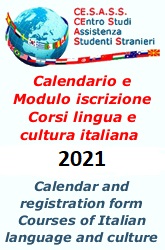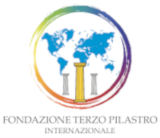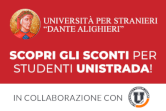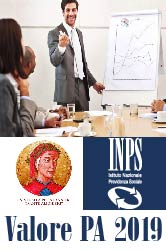- Home
- University
- Teaching
- University research and Centres
- Students
- Library
- Communication
- Transparent Administration
FAQ - CORSI ONLINE DI LINGUA ITALIANA
- VORREI SEGUIRE UN CORSO DI LINGUA: COSA DEVO FARE?
Per seguire un corso di lingua è necessario iscriversi inviando una mail a This email address is being protected from spambots. You need JavaScript enabled to view it. indicando NOME -COGNOME – DATA DI NASCITA – CITTADINANZA – PAESE DI RESIDENZA – LIVELLO già frequentato e allegando la seguente documentazione:
- Fotocopia di un documento di identità personale
- Ricevuta del pagamento effettuato
È importante indicare il paese, la città, da dove avviene il collegamento
- LA FREQUENZA DEI CORSI DI LINGUA È OBBLIGATORIA PER POTER FARE IL TEST?
Per poter sostenere l’esame finale e avere i CFU dovrai frequentare l’80% delle lezioni.
- PER SOSTENERE IL TEST D’INGRESSO COSA DEVO FARE?
Dopo l’iscrizione riceverai una e-mail da un docente che ti darà tutte le informazioni sulle modalità di svolgimento del test.
- IL TEST SI SVOLGE IN UN SOLO GIORNO O IN PIÙ GIORNI?
Per lo svolgimento del test sono previste 2 giornate (mattina o pomeriggio)
- POSSO SOSTENERE IL TEST D’INGRESSO IN UNA DATA DIVERSA DA QUELLA INDICATA DAL CALENDARIO?
Sì, per sostenere il test in una data diversa da quella indicata dal calendario dovrai farne richiesta al momento dell’iscrizione.
- COME SI SVOLGONO LE LEZIONI OFFLINE?
I docenti inviano materiali supplementari, di rinforzo o riepilogo, anche su richiesta dello studente, correggono le produzioni scritte, rispondono alle richieste degli studenti per ulteriori spiegazioni.
- BORSE DI STUDIO
È possibile utilizzare Borse di studio o Premi studio, acquisite precedentemente l’iscrizione, per l’iscrizione ai corsi online di lingua italiana. Al momento dell’iscrizione si deve allegare il documento attestante la gratuità.
- PROMOZIONI
Lo studente può scegliere tra le promozioni offerte quella che più fa al caso proprio.
Sono escluse le Promozioni se l’iscrizione avviene con un promotore.
UniDAcasa - Corsi a distanza di Lingua e Cultura italiana

UniDAcasa - Corsi a distanza di Lingua e Cultura italiana
LUGLIO - AGOSTO - SETTEMBRE 2020
L’Università per Stranieri “Dante Alighieri” offre Corsi di Lingua e Cultura italiana a distanza. Le lezioni si terranno su una piattaforma indicata dal docente, o su Skype.
I Corsi di gruppo sono rivolti a chi desidera conoscere e approfondire la Lingua e la Cultura italiana.
Alle lezioni potranno partecipare un massimo di 10 studenti per ciascun livello.
Ogni lezione dura 60 minuti, l’insegnante fornirà materiali digitali e un costante monitoraggio e supporto offline. Gli insegnanti, altamente qualificati, offriranno lezioni dinamiche e interessanti con studenti provenienti da tutto il mondo con cui interagire come in una vera classe.
I Corsi, della durata di 4 settimane, sono strutturati secondo il modello del Quadro Comune Europeo di Riferimento per le lingue (QCER) e ogni livello è così suddiviso:
| Calendario didattico Luglio - Agosto - Settembre | |||
| DURATA CORSI | TEST-INGRESSO | TEST-FINALE | ULTIMO GIORNO |
| 6-31 LUGLIO | 6 e 7 luglio | 30 luglio |
31 luglio correzione test e presentazione risultati |
| 3-28 AGOSTO | 3 e 4 agosto | 27 agosto |
28 agosto correzione test e presentazione risultati |
| 31 AGOSTO - 25 SETTEMBRE | 31 agosto e 1 settembre | 24 settembre | 25 settembre correzione test e presentazione risultati |
SUDDIVISIONE MODULI E ORE DI LEZIONE
| Livello | Moduli | Numero settimane | Numero ore |
| A1 | 1 | 4 | 5 lezioni Lingua/Conversazione |
| A2 | 1 | 4 | 5 lezioni Lingua e 2 lezioni Conversazione |
| B1 | 2 | 4+4 | 5 lezioni Lingua, 3 lezioni Conversazione, 2 lezioni Lingua Scritta |
| B2 | 2 | 4+4 | 5 lezioni Lingua, 2 lezioni Conversazione, 2 lezioni Lingua Scritta e 1 lezione Esercitazione |
| C1 | 3 | 4+4+4 | 4 lezioni Lingua, 2 lezioni Conversazione, 2 lezioni Lingua Scritta e 2 lezioni Cultura Civiltà |
| Lezioni integrative off-line | 4 | Massimo 10 ore per docente | |
Il livello C2 si attiverà per un minimo di 5 studenti con programma da concordare
Il superamento di un test di verifica, alla fine di ogni Corso di 4 settimane, permetterà l’iscrizione ad un successivo Corso o Livello e consentirà l’acquisizione dei CFU previsti specificati nella seguente tabella:
| Corso | Ore | CFU |
| A1 | 20 | 4 |
| A2 | 28 | 4 |
| B1 | 40 | 8 |
| B2 | 40 | 8 |
| C1 | 40 | 8 |
Per l’ammissione al test di verifica è obbligatoria la frequenza dell’80% delle lezioni.
Al termine dei corsi online, i docenti potranno rilasciare un Premio studio/Borsa di studio allo studente più meritevole per ciascun livello attivato.
ORARIO
| MATTINA | ||
| A1 | 9:00 – 10:00 | |
| A2 | 9:00 – 10:00/10:15 – 11:15 | |
| B1 | 9:00 – 10:00 /10:15 – 11:15 | |
| B2 | 9:00 – 10:00/ 10:15 – 11:15 | |
| C1 | 9:00 – 10:00/ 10:15 – 11:15 | |
| POMERIGGIO | ||
| A1 | 18:15 – 19:15 | |
| A2 | 17:00 – 18:00/18:15 – 19:15 | |
| B1 | 17:00 – 18:00/18:15 – 19:15 | |
| B2 | 17:00 – 18:00/ 18:15 – 19:15 | |
| C1 | 17:00 – 18:00/ 18:15 – 19:15 | |
La fascia pomeridiana si attiverà SOLO con un numero minimo di 4 studenti.
REQUISITI TECNICI
Per partecipare alla lezione servirà:
- una connessione internet
- un computer (o un qualsiasi dispositivo elettronico: tablet, smartphone)
- una webcam e un microfono
*MODALITÀ DI ISCRIZIONE
Per iscriversi ai corsi gli studenti devono inviare una email a This email address is being protected from spambots. You need JavaScript enabled to view it. indicando NOME -COGNOME – DATA DI NASCITA – CITTADINANZA – PAESE DI RESIDENZA – LIVELLO SCELTO- allegando la seguente documentazione:
- Fotocopia di un documento di identità personale
- Ricevuta del pagamento effettuato
(indicare il paese da dove avviene il collegamento)
Il pagamento può essere effettuato con Bonifico Bancario intestato a A:
Università per Stranieri “Dante Alighieri” di Reggio Calabria
Monte dei Paschi di Siena, Via del Torrione 81, Reggio Calabria
COD IBAN n.:IT10L0103016300000002535012
COD. SWIFT PASCITMMREG
Oppure è possibile effettuare un pagamento alla Posta tramite C/C postale n. 15247893 intestato a: Università per Stranieri "Dante Alighieri".
Nella causale del pagamento indicare il nome dello studente, il mese ed il livello corso per il quale si iscrive.
Al momento dell’iscrizione lo studente deve dichiarare il livello che vuole frequentare e pagare la tariffa corrispondente. Qualora, a seguito del test di ingresso, risultasse di livello inferiore o superiore rispetto a quanto pagato, lo studente sarà tenuto ad integrare la quota o a ricevere il rimborso di quanto pagato in eccedenza (a meno che non voglia lasciare l’eccedenza come deposito per l’acquisto di un altro corso).
QUOTE COVID ONLINE
| LIVELLO | 1° MESE | 2° MESE | 3° MESE |
| A1-A2 | 160€ | 160€ | 160€ |
| B1-B2-C1 | 250€ | 200€ | 160€ |
PROMOZIONI
| DENOMINAZIONE PROMOZIONE | OFFERTA |
| Promozione "Porta un Amico" | Sconto del 50% per un mese per lo studente, già iscritto in precedenza, che farà iscrivere un amico |
| Promozione 3x2 | 2 mesi di frequenza a pagamento, il 3° gratuito |
| Promozione gruppi | 1 Gratuità per ogni gruppo formato da 4 studenti |
*INFORMAZIONI
Per maggiori informazioni scrivere a
This email address is being protected from spambots. You need JavaScript enabled to view it.
oppure a
This email address is being protected from spambots. You need JavaScript enabled to view it.
Educational trips
The Ce.S.A.S.S. (Study and Assistance Center for Foreign Students) - to make profitable, and at the same time pleasant, the stay of foreign students enrolled at the University "Dante Alighieri" of Reggio Calabria - presents, in collaboration with the Board of Teachers, the program of educational trips for the year 2015, in order to raise awareness of the historical, artistic and cultural heritage of Calabria.
This program of educational trips and visits to the National Museum of Reggio Calabria, Palazzo della Cultura, Museo del Bergamotto, Pinacoteca Civica and the City Seeing Tour are part of the wide range of services that Cesass delivers to foreign students enrolled in Courses of Italian Language and Culture.
Participation in educational trips will be entitled to a training credit (CFU / ECTS). For all information relating to credits you can refer to the schedule information (into the page for the Courses Italian Language and Culture).
The educational trips are designed to supplement the normal educational and cultural programming and therefore will take advantage of two teachers of the courses Italian Language and Culture who will accompany students.
It is undisputed the instructive importance of the trip involving students, whereas it will enhance even their level of socialization. In fact, the harmony that is created between them on these occasions makes their stay more pleasant and their temporary detachment from family less burdensome.
To this end, the Ce.S.A.S.S. discloses the following program for the year 2019:
* N.B. - The program of educational trips in 2019 may be subject to additions and / or changes, which will be communicated in advance to the participants.
Student Card
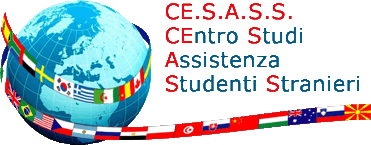
Student Card
The Ce.S.A.S.S. (Study and Assistance Centre for Foreign Students) - on behalf of the University for Foreigners "Dante Alighieri" - offers to its students a student card in order to support students from various countries, who attend Courses of Italian Language and Culture.
The Student Card is a student service, with which you can access to the services, conventions, discounts offered from companies and societies distributed on the territory of Reggio.
Those who are interested in offering services, discounts and special offers to foreign students can fill out the enclosed application and send it by mail to This email address is being protected from spambots. You need JavaScript enabled to view it. or deliver it by hand to the Ce.SASS Office, located within the University. The request for being included is always active and not subject to expiration.

UniDAcasa - Italian language and culture courses for foreigners online
JULY – AUGUST - SEPTEMBER 2020
The "Dante Alighieri" University for Foreigners offers Italian Language and Culture courses online. Lessons will be held on a platform indicated by the teacher, on Skype, at no additional cost.
Group courses are aimed at those who want to know and deepen the Italian language and culture.
Each lesson lasts 60 minutes, teacher will provide digital materials and constant offline monitoring and support. The highly qualified teachers will offer dynamic and interesting lessons with students from all over the world to interact with like in a real class.
Number of participants per course: max. 10
The 4-week courses are structured according to the model of the Common European Framework of Reference for Languages (CEFR) and each level is divided as follows:
| CALENDAR JULY – AUGUST - SEPTEMBER | |||
| DATES | ENTRY TEST | FINAL TEST | LAST DAY |
| 6-31 JULY | 6 e 7 July | 30 July | 31 july test correction and presentation results |
| 3-28 AUGUST | 3 e 4 August | 27 August | 28 August test correction and presentation results |
| 31 AUGUST - 25 SEPTEMBER | 31 August e 1 September | 24 September | 25 September test correction and presentation results |
SUDDIVISIONE MODULI E ORE DI LEZIONE
| Level | Module | Course length week | Lessons in hour |
| A1 | 1 | 4 | 5h Language/conversation |
| A2 | 1 | 4 | 5h Language and 2h conversation |
| B1 | 2 | 4+4 | 5h Language, 3h conversation and 2h written Language |
| B2 | 2 | 4+4 | 5h Language, 2h conversation and 2h written Language and 1h exercise |
| C1 | 3 | 4+4+4 | 5h Language, 2h conversation and 2h written Language and 1h exercise |
| Supplementary off-line lessons | 4 | Maximum 10 hours per teacher | |
C2 Level will be activate with minimum 5 students.
At the end of the online courses, the teachers will be able to award a Study Award/ Scholarship to the most deserving student for each level activated.
Passing a verification test, at the end of each 4-week Course, will allow the registration to a subsequent Course or Level and will allow the acquisition of the ECTS specified in the following table:
| LEVEL | HOUR | ECTS |
| A1 | 20 | 4 |
| A2 | 28 | 4 |
| B1 | 40 | 8 |
| B2 | 40 | 8 |
| C1 | 40 | 8 |
For admission to the test is mandatory attendance of 80% of lessons.
At the end of the online courses, teachers will be able to award a Study Award/ Scholarship to the most deserving student for each level activated.
TIMETABLE
| MOURNING | ||
| A1 | 9:00 – 10:00 | |
| A2 | 9:00 – 10:00/10:15 – 11:15 | |
| B1 | 9:00 – 10:00 /10:15 – 11:15 | |
| B2 | 9:00 – 10:00/ 10:15 – 11:15 | |
| C1 | 9:00 – 10:00/ 10:15 – 11:15 | |
| AFTERNOON | ||
| A1 | 18:15 – 19:15 | |
| A2 | 17:00 – 18:00/18:15 – 19:15 | |
| B1 | 17:00 – 18:00/18:15 – 19:15 | |
| B2 | 17:00 – 18:00/ 18:15 – 19:15 | |
| C1 | 17:00 – 18:00/ 18:15 – 19:15 | |
The afternoon slot will be activated ONLY with a minimum number of 4 students.
TECHNICAL REQUIREMENTS
- Students must have their own PC, notebook, tablet or smartphone
- Students must supply their own Internet connection
- Web cam and microphone
*ENROLLMENT
To enrol students have to send an e-mail at This email address is being protected from spambots. You need JavaScript enabled to view it. writing NAME- SURNAME – DATE OF BIRTH - NATIONALITY – COUNTRY RESIDENCE – CHOSEN LEVEL with the following documents:
- a photocopy of an Identity Card
- enrolement fee’s receipt
PAYMENT TO
Università per Stranieri “Dante Alighieri” di Reggio Calabria
Monte dei Paschi di Siena, Via del Torrione 81, Reggio Calabria
COD IBAN n.:IT10L0103016300000002535012
COD. SWIFT PASCITMMREG
In the purpose of the payment indicate the name of the student, the month and the level of the course for which he enrolls.
At the time of enrollment, the student must declare the level he wants to attend and pay the corresponding rate. If, as a result of the entry test, it is lower or higher than the amount paid, the student will be required to supplement the fee or to receive a refund of the amount paid in excess (unless he/she wants to leave the surplus as a deposit for the purchase of another course
FEES COVID ONLINE
| LEVEL | 1° MONTH | 2° MONTH | 3° MONTH |
| A1-A2 | 160€ | 160€ | 160€ |
| B1-B2-C1 | 250€ | 200€ | 160€ |
PROMOTION
| TITLE | OFFER |
| Bring a friend | If you have attended our courses in the past and you bring a friend with you, you will get a 50% discount for the first month of course. |
| Promo 3x2 | If you place a new enrollment for 3 months at least, you will get a free attendance for 1 month |
| 1 out of 4 for Groups | If you are a group of people, we will grant 1 free attendance out of 4! |
Further information at
This email address is being protected from spambots. You need JavaScript enabled to view it.
.
Enrolment at
This email address is being protected from spambots. You need JavaScript enabled to view it.
Special Offers

Special Offers
The Ce.S.A.S.S. (Centre for Studies and Assistance to Foreign Students) - on behalf of the University for Foreigners "Dante Alighieri" - gives some special offers to foreign students to support students from various countries, who are interested in studying the Italian language and culture in Italy, particularly in Reggio Calabria.
Students interested in one of these offers must apply to Ce.SASS, using the appropriate form.
This special offer is limited to a specific number of submissions.
THE OFFERS SCHEDULED FOR THE YEAR 2015 ARE AS FOLLOWS:
D.A. University Magazine
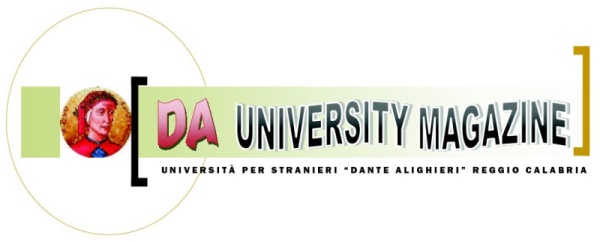
WHAT’S THE DA UNIVERSITY MAGAZINE?
The DA University Magazine is a project promoted by CE.S.A.S.S. (Centre for Studies and Assistance to Foreign Students) of the University for Foreigners "Dante Alighieri" and it consists of the creation of an online magazine, with the participation of all students (Italian and foreign) of the University.
Each month some activities will be proposed by the Intercultural Workshop, which includes 2 monthly afternoon meetings, where students, following a given theme, will have the opportunity to confront and animate a cross-cultural debate and, later, to write articles that will be included in the magazine, according to the elements that will emerge from the comparison.
The main objectives of the project are:
- promoting the reception and integration of foreign students in transit to the University by enhancing cross-cultural exchange, as opportunity for discussion / enrichment, even with the students of Degree courses,
- stimulating the promotion of the University and of its territory in Italy and abroad,
- -maintaining relationships with alumni and encouraging the arrival of prospective students,
- -improving potential and individual talents.
Responsible for the Project:
Dott.ssa Carmela Albano
Dott.ssa Anna Maria Luvarà
E-mail:
This email address is being protected from spambots. You need JavaScript enabled to view it.
Download
Download n.4 of September 2014
Promotions
Starting from March till the end of the 2019, the University for Foreigners “Dante Alighieri” will provide many benefits for its students of the Italian language courses, both newcomer and former ones.
To let you enhance your study experience in Reggio Calabria, the following promotions are open:
- Bring a friend. If you bring a friend with you, no matter if you are a former student or a new one, you will get a 50% discount for the first month of course; a nice boost to start learning with a mate and have fun during all our outdoor activities!
- Promo 3 x 2. In addition, if you place a new enrollment for 3 months at least, you will get a free attendance for 1 month. Also, you can spend this “free ticket” whenever you want during the 2019. Nothing better to extend your stay in such beautiful places than have an entire month of study for free! You can enjoy this promo even if you are just studying here.
- 1 out of 4 for Groups. Meanwhile, if you are a group of people, we will grant 1 free attendance out of 4!
The more, the better! Dante course likes to be a rallying point for all students.
You can easily join these promo by sending your enrollment email at
This email address is being protected from spambots. You need JavaScript enabled to view it.
, specifying at which promo you want to take part.
Carta dello Studente

Carta dello Studente
Il Ce.S.A.S.S. (Centro Studi e Assistenza Studenti Stranieri) – per conto dell’Università per Stranieri “Dante Alighieri” – mette a disposizione degli studenti stranieri una carta dello studente (denominata “student card”) per dare supporto agli studenti, provenienti da vari Paesi, che frequentano i Corsi di Lingua e Cultura Italiana.
La Student Card è una carta servizi per gli studenti, con la quale è possibile accedere ai servizi, convenzioni, sconti ed agevolazioni offerti da strutture e società distribuite sul territorio reggino.
Coloro i quali siano interessati ad offrire servizi, sconti e agevolazioni agli studenti stranieri possono compilare apposita domanda ed inviarla via mail a This email address is being protected from spambots. You need JavaScript enabled to view it. o consegnarla a mano presso l’Ufficio Ce.S.A.S.S., ubicato all’interno dell’Ateneo. La richiesta di inserimento è sempre attiva e non soggetta a scadenza.
More Articles...
Subcategories
University
Degree Courses
Italian Language Courses
Promoters
Communication
Servizi Informatici d'Ateneo






